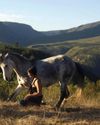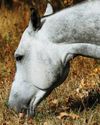Lunging is about much more than just keeping your horse fit and competition ready when you don’t have time to ride.

Combined with your normal schooling routine, it can build up suppleness, rhythm and balance without the weight or hindrance of a rider on your horse’s back, and it can be useful to get the bucks out if you haven’t been able to ride for a few days. When lunging, you get the opportunity to watch your horse move from the ground, so that you can observe how he carries himself and monitor his soundness. Lunging is often used in the training of young horses before they are backed, so that they get used to the feel of walking, trotting and cantering in a controlled area with tack on, and learn to respond to voice commands.
Do
Lunge in an enclosed space, preferably a purpose-built lunging arena, which should be at least 20m in diameter.
Ensure that the surface is even and free of stones.
Protect your horse’s legs with overreach and brushing boots or bandages.
If lunging in a saddle, make sure the stirrups are firmly secured, so that they don’t slide down and bang on your horse’s sides.
Wear gloves to prevent rope burns. It’s also advisable to wear closed shoes and, if your horse is likely to kick out, a helmet.
Use a proper lunge whip and learn to crack it. This is far more effective than trying to chase your horse with it. It’s there to encourage him, not to punish him.
Don’t
Lead your horse to or from the arena with the side reins attached.
Wear spurs, as they could get tangled in the lunge rein and trip you up.
This story is from the July 2017 edition of HQ magazine.
Start your 7-day Magzter GOLD free trial to access thousands of curated premium stories, and 9,000+ magazines and newspapers.
Already a subscriber ? Sign In
This story is from the July 2017 edition of HQ magazine.
Start your 7-day Magzter GOLD free trial to access thousands of curated premium stories, and 9,000+ magazines and newspapers.
Already a subscriber? Sign In

The Science Behind Tapering
The science behind tapering

Horse Treats
The ultimate guide

Horsey Hair Care
Tips and tricks for a healthy mane and tail

Horsey Hydration- The Importance Of Water In Winter
The importance of water in winter

A Horseback Safari
Abelana Game Reserve

The Psychology Of Riding Performance
Intrinsic motivation, part 7

10 Best Life Lessons From Horses
Life lessons from our horses

Breaking New Ground
The evolution of the Callaho Online Auction

Horse Psychology 101
Part 3: The horse's cognitive abilities

Colic Part 1
An owner’s worst nightmare